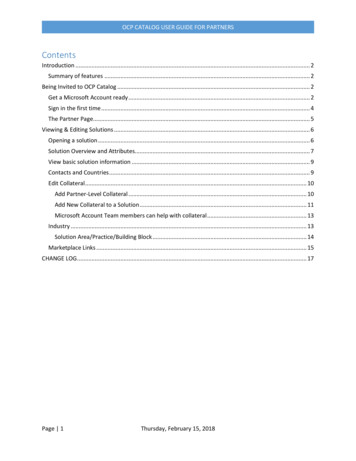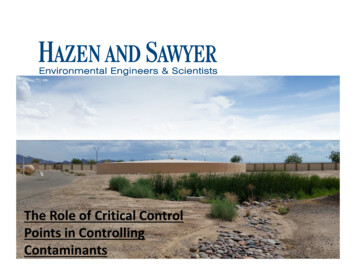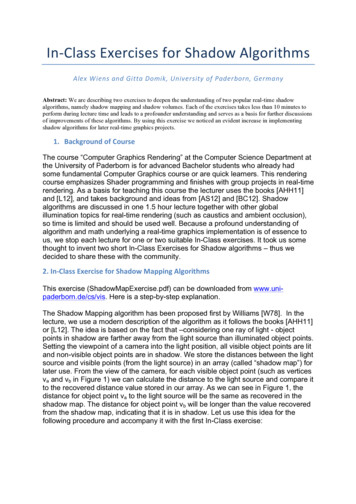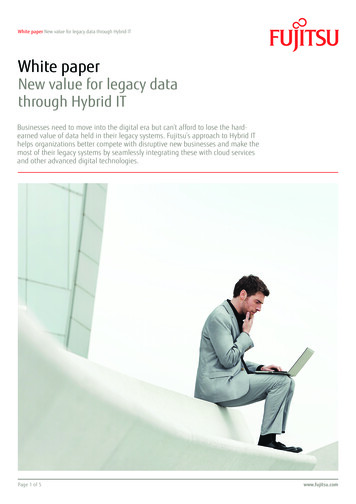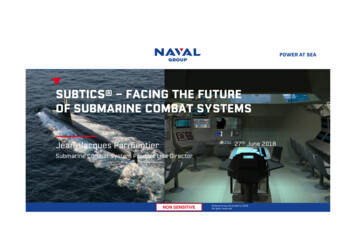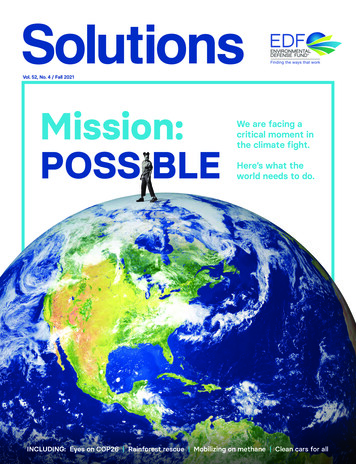
Transcription
Vol. 52, No. 4 / Fall 2021Mission:POSS BLEWe are facing acritical moment inthe climate fight.Here’s what theworld needs to do.INCLUDING: Eyes on COP26 Rainforest rescue Mobilizing on methane Clean cars for all
Whale powerThe population of great whales in Earth’s oceans has plummeted more than twothirds, from an estimated 4-5 million in the days before commercial whaling.Now scientists have discovered a curious fact: this decline has also affected theclimate. Whale waste feeds surface vegetation, which captures C02 from the air.That’s the tip of a rich marine food web which draws carbon toward the seafloor where it can be stored for millennia. Just one more reason why thesemagnificent creatures should be saved.2 Solutions / edf.org / Fall 2021GETTY
Climate change:The message hits homeLooking back, the summer of 2021may be seen as the moment themes sage hit home: Climate changeis here and the world needs to act.From the Amazon to Siberia andacross the United States, heat waves,fires, floods and storms struck, creat ing scenes of tragic devastation.Your investments have funded EDFstaff in China, Europe and the U.S.to help support and strengthen coun tries’ ambitions to act on climate.Now, ne gotiators head to Scotlandfor the global summit called COP26, where I’m hopeful that importantfurther progress will be made (see p. 7 ).Here at home, President Biden set an attainable goal of halving U.S.carbon emissions from 2005 levels by 2030. EDF Action, EDF’s advocacypartner, is a leading voice in Congress on legislation to reduce pollutionwhile decarbonizing our economy. The bipartisan passage of a Senateinfrastructure bill, which invests in mass transportation, electric vehiclecharging stations and power grid modernization was an encouragingfirst step toward our broader goals, which include addressing environ mental injustice.EDF has led a global effort to spotlight methane as a powerful greenhousegas. Our latest study shows that cutting global methane emissions couldslow the rate of warming by 30%. Congress’s restoration of Obama-eralim its on emissions this spring cleared the way for EPA to issue comprehen sive new methane regulations, and we’re working hard to get the strongestones possible (see p. 9 ).The private sector, too, has a critical role to play in slowing climate change.We’re working with automakers to realize the president’s vision that half ofall new passenger vehicles sold in the U.S. be electric by 2030. In addition,we’re working with major fleet operators to hasten the uptake of zeroemis sion trucks and buses, which could have outsized benefits for healthas well as climate (see p. 10). We also helped raise initial commitmentsof over a billion dollars, mostly in private capital, to enable countries toreduce car bon emissions by saving their tropical forests. Billions morein funding is expected for this critical work (see p. 12).Finally, we’re working with major investors on using their leverage to makesustainability a priority for every corporation. That approach bore fruitwhen shareholders elected three new members to the board of ExxonMobilwho pledged to move the company toward a low-carbon future. After thevote, one Wall Street investor told me, “Every CEO in America woke upthinking about what they have to do to tackle climate change.” (See p. 15).Around the world, people have awakened to the reality of climate change.We know what we have to do. We know how to do it. And with your support,we will succeed.In this issue4Field Notes: China’s carbon market6 Mission Possible7 Why COP mustn’t flop9 Methane momentum10 The people’s electric vehicle12 What’s next for rainforests?14 Alaska’s solar surprise15 Investors to business: Don’t get Exxoned16 Arizona vs. drought17 Eureka! Innovation at EDF18EDF Community: Your climate artSenior managing editorSenior writer/editorEditor at largeContributing writersDesignPhoto editorProject coordinatorTasha KosvinerShanti MenonPeter EdidinTom ClynesJoanna FosterTink Tank StudioPaula TrottoKat RossosTalk with useditor@edf.orgSolutions 2021 Environmental Defense Fund. Publishedquarterly in New York, NY. ASSN 0163-2566ENVIRONMENTAL DEFENSE FUNDEDF’s mission is to preserve the natural systemson which all life depends. Guided by science andeconomics, we find practical and lasting solutionsto the most serious environmental problems.257 Park Ave. South, New York, NY 10010212-505-2100Support our workDonate online at edf.org/newsletter or by mail:EDF, Member Services, 1875 Connecticut Ave.NW, Ste. 600, Washington, DC 20009.For inquiries, contact 800-684-3322 oremail members@edf.org.New York / Austin / Bentonville, AR / Boston /Boulder / Raleigh / San Francisco / St. Petersburg,FL / Washington, DC / Beijing / Jakarta / La Paz,Mexico / LondonEDF PresidentSolutions / edf.org / Fall 2021 3
FIELD NOTESIn China, let the trading beginAfter years of preparation, China, the world’s largest greenhouse gas emitter, has beguntrading on its national carbon emissions market. The market is a key element in China’sdrive to produce no net carbon emissions by 2060 and initially covers 2,162 power plants —about 40% of the nation’s total carbon emissions. Already the largest carbon market onEarth, it will eventually expand to include other industries such as chemicals and steel.EDF was invited by the Chinese government to introduce market-based solutions toenvironmental problems in China in the 1990s and prepared the ground for this launchby helping design pilot carbon markets in a number of Chinese cities and provinces.Prior to the start of trading, some 7,000 people trained on market simulation softwarewe developed.“The start of the carbon market marks a major milestone in China’s drive to reachcarbon neutrality,” says Jianyu Zhang, chief representative for EDF China. 1.8 millionThe average amount that onesquare kilometer of coastalwetlands saves a year inproperty damage from storms.Source: PNASGETTYSHUTTERSTOCKADOBE STOCKGETTYEDF prevails against unneeded pipeline250% 7 The predicted increase inthe number of zero-emissionheavy duty truck modelsavailable in the U.S. from2020 to 2023.The number of degrees Fahrenheithotter the lowest income neighborhoods in the U.S. can becompared to the wealthiest ones.The hotter areas have fewerparks and trees, and moreasphalt, buildings and highways.Source: CALSTARTSource: Earth’s Future4 Solutions / edf.org / Fall 2021EDF has won a major victoryin our long-standing fightto stop unnecessary oil andgas pipelines. A federal courtinvalidated the operatingcertificate of the 287 millionSpire STL Pipeline, which runsfrom Illinois to Missouri.The court found that theFederal Energy RegulatoryCommission, which is sup posed to act in the publicinterest, had approved theproject even though therewas no clearly demonstratedneed for additional capacity inthe region. The case will nowreturn to FERC. The 65-milepipeline was completed in2019 and is fully operational.In the wake of the land mark ruling, which may haveimplications for other pipe lines, FERC has faced greaterpublic scrutiny of its authori zation process. EDF is pushingthe commission to update itsreview procedures.
AUSTIN LEE. PHOTO COURTESY OF PACE PRINTSMEET EDFGETTYEmily SteinhilberDirector of Coastal Resilience,VirginiaWhat are you working on?I’m working with other nonprofits,businesses and government to helpVirginia prepare for the impacts ofclimate change.Why Virginia?We have 10,000 miles of coastlineand are already experiencing twiceas much tidal flooding as two decades ago. As the climate changes,rainfall increases and sea levelsrise, it’s going to get even worse.Why a coalition?Rolling backthe rollbacksThe Biden administration will replaceor repeal a Trump-eradecree that openedup much of Alaska’sTongass National Forestto logging, mining andother development. TheTongass locks awayalmost half the carbonstored by our nationalforests and is hometo hundreds of speciesof wildlife.1What will the world look like in50 years?It’ll be wetter in Virginia! But if weget this right, our transportation,housing, energy and other systemswill allow us to thrive.What’s next?Virginia elects a new governor inNovember. Whatever the outcome,we’ll be in there championing ourplan on their first day in office!“I am hopeful that there are solutions to environmentalchallenges that can make a safer world,” says New Yorkbased artist Austin Lee. Lee, working with his gallery, PacePrints, offered a signed edition of 50 prints of “RenderedBirds” to benefit EDF. The sold-out sale raised 44,000.Changing crops in a changing climateIn central Arizona, the devas tating Western drought hasdramatically reduced theamount of Colorado Riverwater available to the region’sfarmers for their crops.In Pinal County, for exam ple, farmers will lose aroundtwo-thirds of their river waternext year.Switching to less thirstycrops will be one step re quired to ensure the survivalof the region’s agriculturaleconomy. To help prepare,EDF has teamed up withBridgestone Americas and alocal farmer to test guayule,a drought-tolerant desertshrub that can be used toproduce rubber for tires.Guayule requires roughlyhalf as much water as alfalfa,one of the region’s dominantcrops. When combined withother materials, 10 acrescan produce over 500 tires.EDF and Bridgestone hopeto expand the project, whichbegan on just 40 acres in2018, to over 20,000 acreswithin three years.“Guayule could helpensure farming remains eco nomically viable in centralArizona,” said Kevin Moran,senior director of EDF’sColorado River program.REUTERS EVENTSEPA will reconsider the Trumpadministration’s decision to leave in placeinadequate protectionsagainst dangerous particle pollution emitted bypower plants, cars andother sources. Failing tostrengthen those standards results in 50,000premature deaths everyyear. EDF and partnersfiled suit to get strongerprotections enacted.2Individuals often play whack-a-molewith solutions. They might go afterone fix — like building sea walls tohold back floodwater — but maynot consider how it impacts localcommunities. Coalitions providemultiple perspectives to producesolutions that are good for all.Art for environmental actionSolutions / edf.org / Fall 2021 5
Mission PossibleSeizing theclimate momentFlooded rivers tearing through Europe. Torrential downpoursin India, China and the northeastern U.S. Yet another hurricane ripping into Louisiana and historic wildfires on multiplecontinents. Climate change is everywhere, circling closer.As dire as things seem, environmentalists have never beenpessimists. We fight for the climate because we know successis possible. We have the tools to drasticallyslash climate pollution by shifting toelectric vehicles, cleaning up energyproduction and protectingthe world’s tropical forests.Can we put these solutions towork at the scale and speedrequired to stave off climatecatastrophe? We have anopportunity like no other. TheBiden administration has a planto halve U.S. climate pollutionby 2030. Congress has restoredregulations on methane, and majorcompanies are reshaping themselvesto deliver climate action. All this, asthe world heads to Glasgow for the mostconsequential climate summit since Paris.“You can feel the world pivoting back to climateaction,” says Kelley Kizzier, who leads EDF’s international climate work. “We just might have the right mixof urgency and momentum to push the planet backon track.”UNSPLASHIn this special climate issue of Solutions, we examine thegroundbreaking work that has brought us to this moment,and — with the right push — can carry us into a more stableclimate future.6 Solutions / edf.org / Fall 2021
MISSION POSSIBLE: COP26A global climate reckoningMore than 200 countries, six official languages,30,000 people and 12 nearly sleepless days.Will COP26 be the climate summit the worldis waiting for?Climate change has now touchedevery nation on the planet, sub merging shores, burning forests,flooding fields and drying out rivers.According to the most recent UnitedNations report, climate change is accel erating, the world is locked into 30 yearsof worsening impacts and the planet ispoised to blow past the crucial 1.5 C(2.7 F) warming limit by the early 2030s.After decades of procrastination, theworld now has just a few short years leftto slash greenhouse gas emissions in halfor face catastrophic climate change.This is the backdrop as the worldconverges on Glasgow, Scotland, thisNovember for the 26th annual Conferenceof the Parties to the United NationsFramework Convention on ClimateChange — COP26, for short.SYON GEOGRAPHICAL LTD.It is the most critical COP since 2015,when nations committed, under thelandmark Paris Agreement, to holdingglobal warming to well below 2 C (3.6 F)above pre-industrial levels. The pollutionreduction targets they submitted backthen — while better than none at all —would still lead to a more than 3 C(5.4 F) increase in warming, makinglarge parts of the Earth uninhabitableand endangering global food supplies.In preparation for this year’s COP, allparties to the Paris Agreement are ex pected to unveil new, hopefully muchmore ambitious climate targets.Whether they will do enough to staveoff climate catastrophe, or continue tokick the can down the road, remainsto be seen.“I call this the ambition COP,” saysKelley Kizzier, EDF’s Associate VicePresident for international climate. Theurgency is palpable and the momentumencouraging. The EU, U.K. and U.S. haveall come forward with solid targets in linewith the scale of emissions cuts neededto cap global warming at 2 C or even1.5 C. But immense challenges remain.China has pledged to be carbon neutralbefore 2060, but hasn’t yet submittednearer-term goals. Other major emitters,such as Australia, Brazil and India, haveyet to make pledges of their own.One tool that would help make bigreductions achievable is internationalcarbon markets. EDF has calculated thatsuch markets could help the world doubleits emissions reductions at no additionalcost. “But it has to be done right,” saysKizzier. These markets allow polluters tofund carbon reducing measures abroad— such as protecting tropical forests — inaddition to emissions they must reduceat home. But there are challenges. Thereductions achieved through carbonmarkets must be independently verifiedand the system needs to ensure that thereis no “double counting” where both abuyer and seller can claim the samereduction. One heavy lift for COP negotia tors will be ironing out wrinkles like theseto complete the rules that govern howinternational carbon markets work.Another sticking point is ensuring therichest countries, which include some ofthe biggest polluters, support developingand emerging economies. In 2010, devel oped nations pledged 100 billion peryear by 2020 to help developing coun tries reduce emissions and adapt to theimpacts of climate change. Under theParis Agreement, countries agreed tobuild upon this pledge. Adds Kizzier: “Wealso know public sector finance will notbe enough. It needs to spur private sectorinvestment to begin to scratch the sur face of what it will actually take to helptheworldtransitionto cleaneconomies and pre GETTYpare for the impactsof climate change.”Despite these chal lenges, and previousCOP’s mixed record ofsuccess, the meeting isstill the only existing global forum forcritical climate discussions, and theonly climate forum in which all coun tries’ concerns carry equal weight,regardless of size. Agreement can onlycome by consensus. This is what givesCOP decisions global authority — thoughit means it can take only one countrydragging its heels to stymie more ambi tious action.“If we didn’t have a COP, we’d have toinvent one,” says Kizzier.Kizzier says she feels the same kind ofenergy leading up to COP26 as she didbefore Paris.“Paris saw almost every nation in theworld agreeing to take action towards acommon cause,” she says. “It was a para digm shift. This year, everyone is fired upagain imagining what is possible.”Joanna FosterEMISSIONS AMBITIONSReduction goals by 2030US5052%EU55%UK68%Solutions / edf.org / Fall 20217
D EMPI ASRSTI OMNE NP TO SS ST IABNL DE I: NCGO HP2E6ADThe Basics: COPCOP stands for Conference of the Parties to the United Nations Framework Convention on Climate Change.It’s the only global forum at which all countries gather to confront the climate crisis. As many as 30,000people attend each year including delegations from more than 200 countries, representativesfrom dozens of official observer organizations, including EDF, and journalists fromaround the world.The highs and risGlasgow154 countries signthe United NationsConvention onClimate Change,setting out waysto avoid the mostdisastrous effectsof climate change.Developed nationsrepresenting abouthalf of globalemissions pledgeto reduce theirclimate pollution.The summitfails to set basictargets forreducing emissions or securecommitmentsfrom countries.195 countries andthe EU pledgeto cut emissionswith the goal oflimiting globalwarming to lessthan 2 C (3.6 F).Countries areexpected topledge newclimate targets,we hope muchmore ambitiousthan Paris.COP: An insider’s viewIISD/ENB - KIARA WORTHKelly KizzierEDF’s Kelley Kizzier has been atevery COP but two since 2005,both as the EU’s lead marketsnegotiator and as an officialobserver with EDF.“I would lovingly describe it as structured chaos,” says Kizzier, who notesthat 20-hour days are unexceptional.“Figuring out where you’re supposedto be at any given time and howto eat and sleep enough to remain8 Solutions / edf.org / Fall 2021coherent can be a challenge. I’ve seengovernment officials snoozing on a lobbycouch, because sometimes a nap isnon-negotiable.”As an official observer organization, EDFcan sit in on most of the negotiations.“Being an official observer gives usvaluable insights into what or who isblocking progress and whether talks areheaded in the right direction or fallingapart,” Kizzier explains.Outside of the U.N. meetings, EDF hostsevents to raise awareness about keyissues. This year, EDF will be highlightingthe importance of controlling methaneemissions from oil and gas operations,doubling down on efforts to protecttropical forests and calling for greaterambition and speed in the transition tovehicle electrification.“You can’t swing a cat at a COP withouthitting an EDFer,” says Kizzier. “We’reeverywhere trying to get our message out.”Our economists, scientists and policyexperts are also on hand to helpjournalists make sense of issues sothey can explain to the rest of the worldwhat is happening and why it matters.“In Paris,” recalls Kizzier, “we had agaggle of journalists from the world’s toppublications all huddled around a foldingtable as former EDFer Nat Keohane readthrough the latest text of an agreementand called out what details had changedand what it meant.”“COPs are a roller coaster ride —frustrating, hopeful, exhausting andexhilarating,” says Kizzier. “I’m a nerdand an optimist, and I look forward tothem all year.”
MISSION POSSIBLE: METHANEWorld leaders take aim at climatepollution from methaneFrom Washington to Brussels to Beijing, new rulesare on the way to cut the pollution that is makingthe planet hotter, faster.GETTYThe Permian Basin is the world’s largest oil field and a big source of U.S. methane pollution.This summer, during the hottestJune in recorded U.S. history,Celerah Hewes of Albuquerque,New Mexico, urged the EPA to cut cli mate pollution from methane. Methanehas more than 80 times the near-termclimate warming power of carbon diox ide and is responsible for at least a fullquarter of the warming that we areexperiencing today.“On her first day of summer camp, mydaughter suffered a heat stroke,” saidHewes, a member of EDF affiliate MomsClean Air Force, who spoke at an EPAvirtual public hearing. “On the third day,I had to explain to her that she couldn’tplay outside because the air was dirtyfrom wildfires. We have to address cli mate change now, before this becomesthe new normal.”As millions sizzled in the recordbreaking heat, Congress cleared the wayfor the EPA to act. Delivering a big winfor climate, a bipartisan majority inCongress voted to reinstate Obamaera regulations on methane pollutionfrom the oil and gas industry. The votereversed one of the Trump administra tion’s most damaging climate rollbacksand immediately restored protectionsfor communities affected by oil andgas pollution.It also opened the door for the EPA tomake deeper cuts to methane pollution,as Hewes, EDF methane experts andhundreds of others urged the agency todo. At press time, the EPA was expectedto issue proposals this fall to strengthenmethane regulations on new oil and gaswells and, for the first time, to regulatemethane from 800,000 existing wells thataccount for the bulk of the industry’smethane pollution.A key climate solutionCutting oil and gas methane pollutionis the fastest, cheapest way to slowdown global warming. Methane is themain component of natural gas, andit can leak or be purposelyreleased from oil and gasoperations and equip ment. EDF estimatesshow that the industry isresponsible for nearly halfof U.S. methane pollution.Once detected, manyleaks can easily be fixed.The industry can cut itsmethane pollution by75%, according to theInter-national EnergyAgency, by widely adopt ing technologies andpractices already in use. More than halfof those reductions can be made at nonet cost to industry.According to a recent study by EDFclimate scientist Dr. Ilissa Ocko, usingexisting technology to cut all methanepollution in half by 2030 could slow therate of global warming by as much as 30%.Curbing oil and gas methane alsoreduces pollutants often released alongwith methane, such as cancer-causingbenzene and smog-forming chemicals.More than 9 million people in the U.S.live within half a mile of an active oiland gas well and risk exposure.Sue Franklin of Fort Davis, Texas,is one. “Many nights I woke up chokingwith the rotten egg smell of sulfur diox ide,” Franklin told the EPA. “I had severeheadaches and breathing problems thatI never had before,” she testified. “I begyou to please take action so people arenot driven out of their homes.”Global momentumEDF has been building the case formethane regulations in the U.S. andbeyond. China and the EU are now bothdeveloping new rules to limit methanepollution. And at the COP26 climatetalks in November, major oil and gascompanies and the countries that buytheir products could agree to tacklemethane together.“The world is waking up to the factthat we have to cut methane as well ascarbon dioxide,” says EDF’s energy headMark Brownstein. “We have to seize thiscritical opportunity for climate action.”Shanti MenonSHUTTERSTOCKSolutions / edf.org / Fall 2021 9
MISSION POSSIBLE: TRANSPORTATIONClean cars for everyoneAn iconic American pickup truck is going electric,ushering in a new era of pollution-free driving.ANDI HEDRICK/CAR AND DRIVER MAGAZINEFord’s f-series pickups havebeen the top-selling vehicles in thecountry for nearly 40 years and, thisfall, buyers will be able to order the newF-150 Lightning. It’s the fastest F-150 yet,with a towing capacity of 10,000 poundsand a near-instant torque that promptednoted automotive expert Joe Biden toannounce, after a test drive this spring:“This sucker’s quick!”The truck, which rolls out in 2022 witha starting price of less than 40,000, runsentirely on electricity.Ford’s decision to make its brawny,beloved workhorse vehicle fully electricrepresents a turning point in the auto in dustry, as does GM’s decision, on whichEDF advised, to sell only zero-emissionvehicles by 2035. Until recently, electricvehicles were mostly niche products,marketed to environmentally consciousconsumers or well-heeled enthusiasts.As recently as 2017, some major automanufacturers lobbied the Trumpadministration to roll back U.S. andCalifornia clean car laws. But this sum mer, the Big Three automakers andUnited Autoworkers stood besidePresident Biden as he announced hisgoal of making half of all new cars soldby 2030 free of tailpipe pollution. Ford,GM and others envision EVs meeting theneeds of every driver, not just a select few.More than 120,000 people across thecountry have already put down a 100deposit to reserve the Lightning. GMplans to make an electric Silverado pick up; Tesla’s Cybertruck, also priced under 40,000, is expected to enter productionin 2022.Robert McKeon, who runs a 550-acrefarm in Red Hook, New York, hopes to beone of the first to get a new electric pick up. He used a conventional pickup foryears to haul his livestock and transportbales of hay and bushels of apples. Butwhen his truck died three years ago,McKeon held off on replacing it. He’sbeen contracting out big hauling jobs toa fellow farmer, and making do with hisold SUV for moving smaller loads.“Throwing goats in the back of theSubaru got old pretty quick,” saysMcKeon, whose daughter Natalie worksfor EDF. “I’m dying for a pickup, but Idon’t want to buy another gas vehicle.It’s bad for the environment. And I thinkit’s a bad investment. The maintenancecosts are high and they depreciate rightoff the lot. I’m waiting for electric.”Automakers are betting on a wave ofEV customers like McKeon. Worldwide,they plan to invest more than 340 bil lion in electric vehicles through 2030;about 52 billion has already been an nounced as being headed for America,where two factories in Michigan aloneare expected to create more than 5,000Farmer Robert McKeonMCKEONRapid EV-olutionISTOCK10 Solutions / edf.org / Fall 202120112018EV models available314Average range73 miles125 miles
MISSION POSSIBLE: TRANSPORTATIONCutting 15 billion tonsof carbonEDF is urging the Bidenadministration to establishpollution standards underthe Clean Air Act that wouldhit these targets, cuttingmore than 15 billion metrictons of carbon pollution —more than twice U.S. annualemissions — by 2050. Suchstandards would also preventmore than 150,000 prematuredeaths due to air pollutionby 2050.EDF is also working withmajor manufacturers andcompanies, including FedEx,GM, IKEA and others, to ad vance clean vehicle strategies.FedEx recently announcedthat all of its parcel pickupand delivery vehicles willbe electric by 2040. IKEA isaiming for all its home deliv eries to be zero emissions by2025. In all, 17 companiesthat operate large vehiclefleets have committed totransition all or significantparts of their fleets to electricvehicles. Fourteen more haveset targets to cut emissionsby at least 50% by 2035.The industry is not entirelyunited behind zero-emissionsvehicles, however. Toyota isreportedly lobbying to slowdown the transition, arguingagainst the new rules andinvestments that couldsqueeze out its gasolineelectric hybrids sooner.The U.S. government is notthe only driver of change. InJuly, the EU proposed legislation that would require allnew cars and vans sold tobe zero emissions by 2035.The UK and Canada havealso announced similar plans.California is expected to adoptstandards in 2022 that wouldhit this target.For McKeon and othersready to make the electricswitch, the new wave of EVscan’t come quickly enough.“I’m dying for a new pick up,” McKeon says. “I can evenuse this one for backup power.I can’t wait to show other folksthe benefits. Everyone’s goingto want one.”Clean air for everyoneGETTYjobs. Most analysts predictthat the lifetime cost of EVownership will equal that of agas-powered vehicle by 2025.“The transition is happen ing,” says EDF Senior CounselPeter Zalzal. “But if we want toprotect climate and health,how fast it happens matters.And that is where Washingtoncomes in.”Transportation is the num ber one source of climate pol lution in the United States anda major source of air pollution.Making all new passenger carsand trucks zero-emissions by2035 and freight trucks andbuses zero-emissions by 2040is critical for the U.S. to reachits climate goals and protectthe health of communities.Pollution from vehicles doesn’tonly damage the climate —it kills.And it’s not evenly distributed.Highways, bus depots and otherpollution sources are often locatedin communities of color — adisparity that springs in part fromdecades of racist policies anddisenfranchisement — exposingresidents to greater harm.An EDF block-by-block study of air quality and healthin the San Francisco Bay Area found that, on average,neighborhoods with more people of color face double therate of childhood asthma from traffic pollution comparedto predominantly white neighborhoods.The disparities can be extreme. In West and DowntownOakland, where most residents are people of color, as manyas half of new childhood asthma cases were due to trafficpollution. By contrast, in a predominantly white OaklandHills neighborhood, this pollution gave rise to 20% of newchildhood asthma cases.“Kids who never had asthma now have a health conditionthat will probably burden them for a lifetime,” says EDFhealth scientist Ananya Roy, who led the study. “This couldhave been prevented.”Mapping air quality and health data at the neighborhoodlevel — an approach pioneered by EDF and our communitypartners — could help guide the rollout of electric vehiclesand charging stations to neighborhoods where air pollutionreductions are most needed. EDF plans to expand this workto additional cities in the coming months.Eliminating pollution from all new trucks and buses by2040 would prevent more than 57,000 premature deathsdue to air pollution. “That’s great motivation to focus onelectrification,” says Roy.Shanti Menon20212022–20247285-100248 miles275 milesSources: US DOE; MJ Bradley EV Market Update; Consumer ReportsSolutions / edf.org / Fall 2021 11
Rainforest reliefISTOCKMISSION POSSIBLE: RAINFORESTSRooted in EDF’s decades of work in the Amazon,new initiatives help companies deliver on pledgesto preserve tropical forests and slow climate change.TCustomers and investors are increas ingly calling on companies to accelerateaction on fo
Senior managing editor. asha Kosviner T Senior writer/editor Shanti Menon. Editor at large Peter Edidin Contributing writers Tom Clynes . Joanna Foster. Design Tink Tank Studio Photo editor Paula Trotto Project coordinator Kat Rossos Talk with us. editor@edf.org Solutions 2021 Environmental Defense Fund. Published . quarterly in New York, NY .
